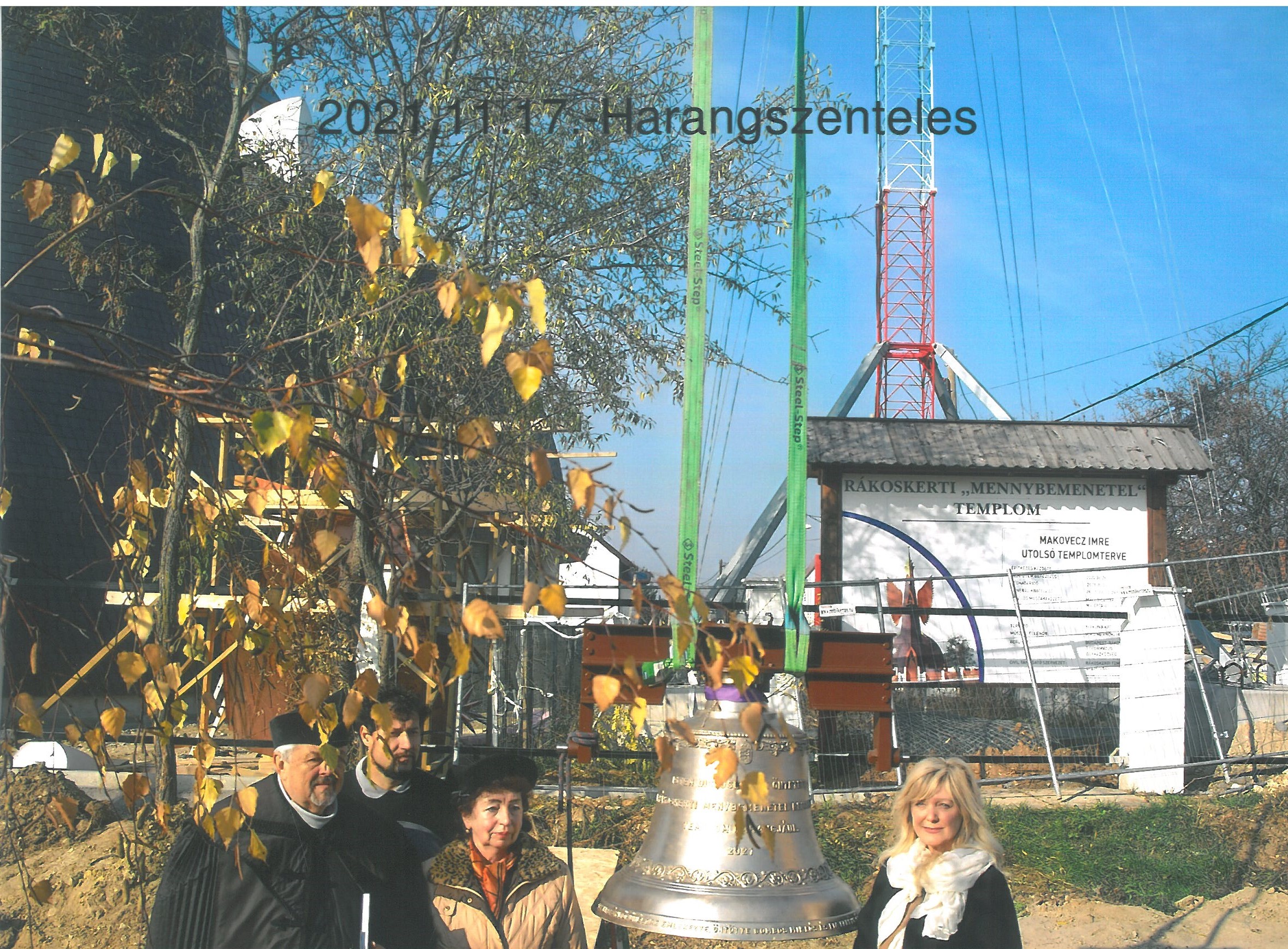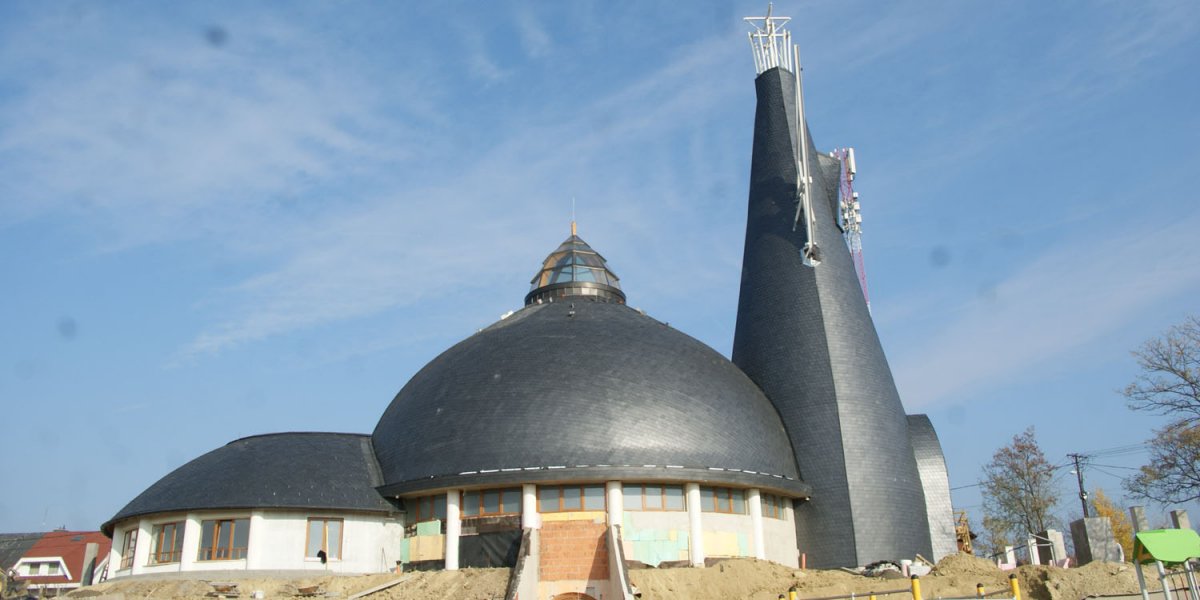In the 17th District, also known as Rákosmente, inhabited continuously in the area of Rákoscsaba and Rákoskeresztúr since the Árpádian era, archaeologists have excavated medieval churches that have now been destroyed. The youngest part of the district is Rákoskert, during the plotting of which the planners designated a larger area in the early 1930s, according to the idea of the owner of the area, Baroness Gyuláné Schell, which was left in municipal property for the purpose of building a church. This area is located in the part bordered by today's Rózsaszál Street, Tiszanána Street and Tiszaörs Street. However, the anti-church decades after World War II and the dictatorial turn from 1948 did not allow the plan to materialise. However, after the change of regime, the desire to build an ecumenical church was expressed in the faithful community of the district.

Design render of the church in Rákosmente (Photo: rakosmente.hu)
The intention to build a church in connection with the lack of a sacred building was also manifested in concrete actions in the 21st century. In the spring of 2003, some citizens of Rákosmente, who were deeply committed to the case, joined forces and established the Rákoskert Church Foundation, which was registered with the Budapest-Capital Regional Court on 6 January 2004. As a result of the work of the foundation, by the beginning of 2005 an agreement was reached in principle with the local government of the 17th District of Budapest to hand over the area originally intended for the church to its original purpose.
As a result of several years of persistent applications, the plot was reclassified in 2008. On the part of the historical churches, the Budapest-Rákoscsaba Reformed Parish undertook the handling of the construction of the ecumenical church in Rákoskert. The leadership of the parish and the president of the foundation asked Imre Makovecz (1935-2011) to make the plans.
.jpg)
Plan of the church in Rákoskert
Imre Makovecz was commissioned to design his first church buildings in the last decade before the change of regime. In Siófok, the congregations of the Finnish Lutheran church provided significant support in the realisation of the Lutheran
“holy shelter”. The presentation of the angel wings of different sizes can be observed in the formal design of the church on the shores of Lake Balaton. The Roman Catholic Parish Church of the Holy Spirit in Paks is a work of special value of the same “transitional age”. The novelty of the main facade of the Tolna County catholic church was the opening of the upper part of the bell tower with a window opening.
On Makovecz's sacred work in Paks not the symbolic angel wings, but an angel statue as the protector of the sanctuary is the defining artistic sign. After the change of regime, the master was able to design churches for several Christian churches in the Carpathian Basin. Beyond the denominational needs, these churches of Makovecz realised the role of the church as a link between man and God, and were also as an intimate home for the building community in addition to the main aspect.
.jpg)
The chapel of Devecser is a scaled copy of the church in Rákoskert (Photo: Máté Millisits/pestbuda.hu)
One of the last works of Imre Makovecz's life, which frames his oeuvre, is related to the red mud disaster in Kolontár and Devecser in October 2010, where he designed residential buildings and an ecumenical chapel, which was consecrated in 2012, in Devecser to commemorate the tragedy.
.jpg)
The church of Imre Makovecz in Devecser is a scaled-down copy of the church in Rákoskert under construction (Photo: Máté Millisits/pestbuda.hu)
This small building can also be seen as a scaled-down version of the Rákoskert church, as the dome covering the sacral space, the architectural elements depicting the angel wings encircling the tower on both sides, and both arched windows at the height of the wings are all "Makovecz features".
After his death in 2011, several church plans of Imre Makovecz waited for years to be built at the right time. The consecration of the church of the Pesterzsébet-Szabótelep Reformed Parish in Budapest took place in September 2021. During the design of this church in 2011, a few months before his death, Imre Makovecz was only able to make a few sketches, the scale design praises the work of Tamás Dósa Papp, a student of Makovecz.

The church of the Budapest-Pesterzsébet-Szabótelep Reformed Parish was consecrated this year (Photo: MTI/Zoltán Máthé)
The plan of the church with an ecumenical spirit in Rákoskert was prepared by Imre Makovecz in the summer of 2009, and then on 23 August of that year, the foundation stone was laid in the presence of the master. The local government of the 17th District and the Budapest-Rákoscsaba Reformed Parish concluded a land use contract in 2011, thus ensuring that legal obstacles to the construction of the church were removed.
Thanks to the proceeds from the donations of the Rákoskert Church Foundation, the builder Reformed parish already had a valid building permit in 2013. Depending on this, the foundation and the parish received a state grant of 520 million HUF in 2016 from the Makovecz Imre Fund established by the Hungarian Government in 2016, which aims to fully nurture Imre Makovecz's oeuvre and to build plans that have not been implemented due to lack of financial resources.
The top of the church tower is still on the ground (Photo: Máté Millisits/pestbuda.hu)
The construction of the Church of the Ascension in Rákoskert started in 2019. The spectacular progress of the works was signalled by the topping off ('bokrétaünnepség') on 22 June 2020. Although, according to the tradition of a centuries-old master's workshop, this celebration is kept when a building reaches its highest point during construction, in Rákoskert this ceremony was organised when the metal frame of the tower was built. The bell tower will reach a height of 37 metres at the end of November 2021, when the copper church peak element, reminiscent of a plant ornament, together with the “Star of Bethlehem” closing ornament pointing to Jesus Christ, is lifted into place.

The structure of the Rákoskert tower from the inside (Photo: Máté Millisits/pestbuda.hu)
One week before the lifting of the star, the consecration of the church bell in memory of Imre Makovecz was held at 11 a.m. on 17 November, 2021. Zoltán Füzesi, the chief pastor of the Budapest-Rákoscsaba Reformed Parish, said the blessing and prayer prescribed for the bell and the celebrating congregation by the Reformed agenda.

Consecration of the bell (Photo: Máté Millisits/pestbuda.hu)

Consecration of the Reformed Church of the Ascension in Rákoskert on 17 November 2021 (Photo: Máté Millisits/pestbuda.hu)

Lifting the bell in (Photo: Máté Millisits/pestbuda.hu)
The highlight of the bell is the large chalice, which is reminiscent of the common symbols of Protestant art dating back to the Hussites, the blood and redemptive sacrifice of Jesus Christ on the cross for humanity. Below the chalice is the Latin slogan of the prominent Geneva reformer, János Kálvin (1509-1564): “SOLI DEO GLORIA”. The bell weighing 325 kg was cast in their workshop in Őrbottyán by master goldsmith Miklós Gombos and his son, Ferenc Gombos.

The bell of the church was cast by Miklós Gombos and his son, Ferenc Gombos (Photo: Máté Millisits/pestbuda.hu)
The inscription on the bell: "Soli Deo Gloria" (Photo: Máté Millisits/pestbuda.hu)
According to the information of the leaders of the building parish, it is known that the church is expected to be consecrated in the spring of 2022 according to the Reformed liturgy. The original intention of the foundation initiating the construction of the church to be an ecumenical church is to be solved by the Budapest-Rákoscsaba Reformed Parish by making the part of the crypt under the church available to other historical Christian churches and inviting their representatives to bless it.
The capacity of the church can ensure the participation of two hundred to three hundred people in worship services. Adjacent to this space, covered by a large worship dome, are the service rooms in a smaller wing with a semicircular floor plan in the longitudinal axis of the building.
It is planned that two thousand urns will be placed in the sub-church blessed with an ecumenical ceremony. Based on the information of the pastor Zoltán Füzesi, it is known that the lower level will be decorated with several works of art. The depiction of Christ by the sculptor Hargita Mecseki is placed in the prominent part of the sub-church, below the bell tower, while the memory of those who died in air disasters is honoured by a monument on the western crypt wall, made by sculptor Mónika Laborcz.
Cover photo: Church of the Ascension in Rákoskert (Photo: Máté Millisits/pestbuda.hu)




































Hozzászólások
Log in or register to comment!
Login Registration